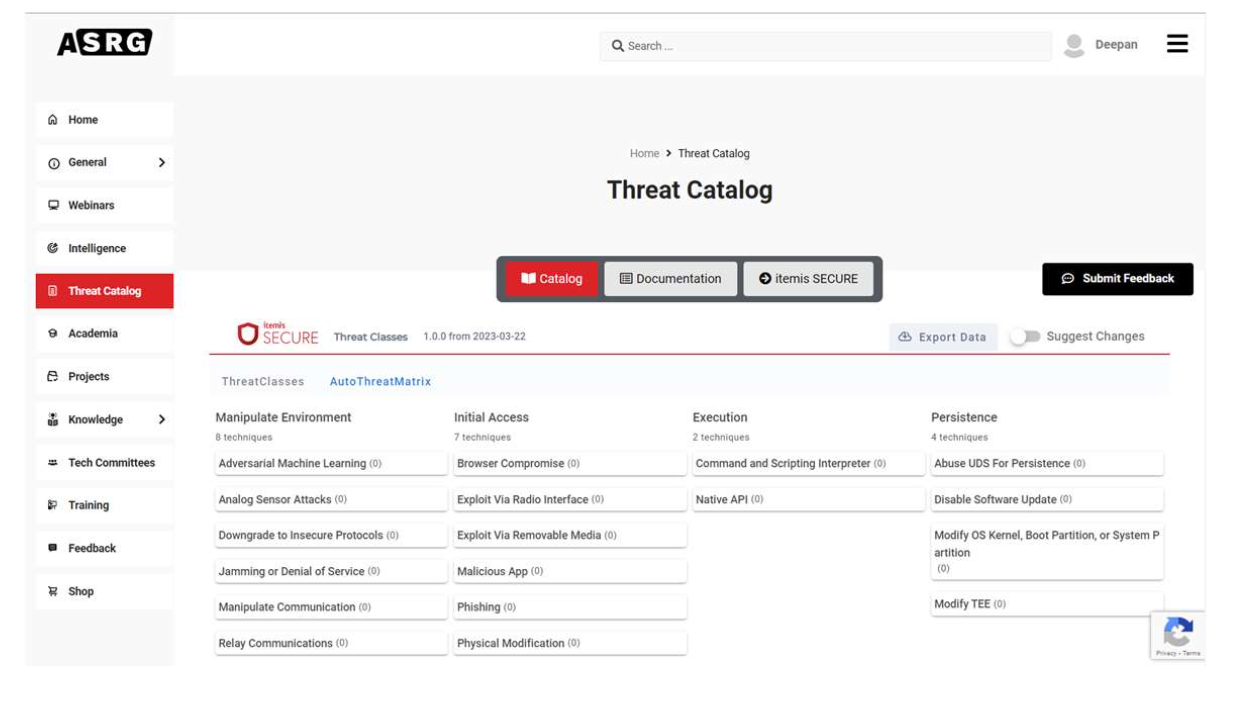Need for Cybersecurity in Automotive
- Automotive Innovations Driving the Increased Risk of Cyberattacks
- Autonomous vehicles, Connected Infrastructure, Electric Vehicles
- Increasing Cyber Threat Landscape for vehicles
- Presence of 100s of Electronic Components
- Over 100 million lines of code is used
- Standards and Regulations
- ISO 21434
- UNECE WP 29 R155 and R156
- Security is a safety issue in vehicles
Cybersecurity Standards and Regulations
- UNECE Cybersecurity Regulation - UNECE WP.29 R155 & R156
- ISO 21434 - Road Vehicle Cybersecurity Engineering Standard
UNECE WP.29 R155 and R156
- Regulation establishes performance and audit requirements for cybersecurity and software update management for new passenger vehicles
- WP.29 applies to the 54 countries
- Automakers to implement measures to
- Manage vehicle cybersecurity risks
- Secure vehicles by design to mitigate risks along the supply chain
- Detect and respond to security incidents across the vehicle fleet
- Provide safe, secure software updates that do not compromise vehicle safety
ISO 21434 - Road vehicles — Cybersecurity Engineering
- Specifies engineering requirements for cybersecurity risk management
- E/E systems in road vehicles
- Components
- Interfaces
- Defines a framework
- Minimum Requirements for cybersecurity processes
- Common language for communicating and managing cybersecurity risk.
- Covers Cybersecurity Management and engineering processes
ISO 21434 - Applicability
- E/E systems, including their components and interfaces, whose development or modification began after the publication of ISO 21434.
- Activities along the product lifecycle are covered
- Concept Phase
- Product Development
- Production
- Operation
- Maintenance
- Decommissioning
- Impact all players in the automotive industry from OEMs to Tier- N suppliers
ISO 21434
- 15 Clauses
- 37 Sub-Clauses
- 101 Requirements
- 13 recommendations
- 4 permissions
Threat Analysis and Risk Assessment
- TARA is a comprehensive risk assessment
- Clause 15 of the ISO/SAE 21434 outlines the basic elements of a risk assessment
- Core activities in a TARA
- Item definition
- Asset identification and impact rating
- Threat scenario identification
- Attack path analysis
- Risk determination and treatment
Cybersecurity Goals and Claims
- Cybersecurity Goals
- Concept level cybersecurity requirements associated with one or more threat scenarios
- Cybersecurity goal would include the protection of assets that if compromised would lead to a damage scenario
- Example: The storage and transmission of data should be secure and should be controlled
- Cybersecurity Claims
- Risks that cybersecurity goals do not account for but are still applicable to the scenario
- Fail-safe mechanism when the accounted risks occur
- Cybersecurity claims are used to explain why risk retention or sharing are considered adequate.
- Example: Lock the device after 5 failed attempts
Cybersecurity Concept and Plan
- Cybersecurity Concept
- It is to verify and ensure conformance with the cybersecurity goals and consistency and compatibility with the functionality of the item
- cybersecurity requirements of the item and requirements on the operational environment with associated information on cybersecurity controls
- Example: To protect the vulnerability this should be done in x amount of time to protect the feature (Testing)
- Cybersecurity Plan
- Specifies what is required to maintain the concept in a concise way.
Interaction in Concept Phase
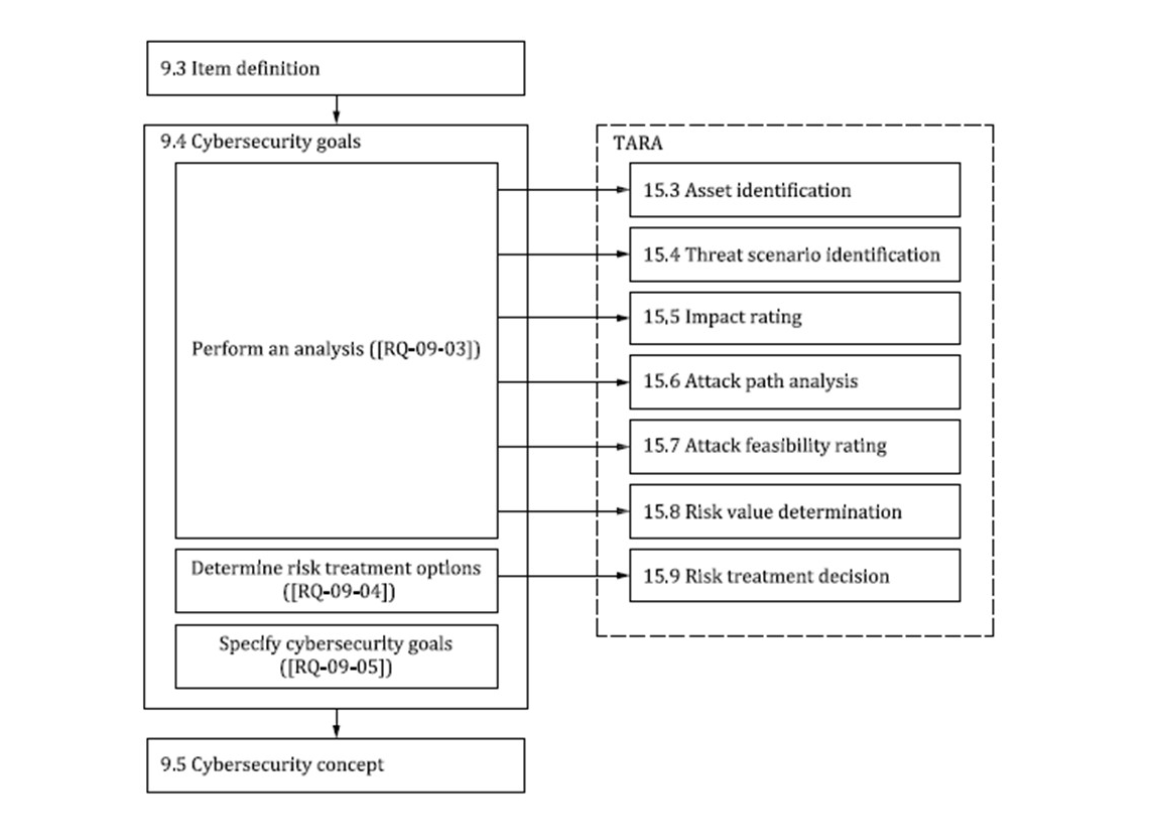
Item Definition
Item Boundary
- Interactions of interfaces with the vehicle or E/E systems externally
Item Functions
- Describing the behavior of the interfaces
- Describe the operational environment
Preliminary Architecture
- Identifications of components, connections and external interfaces
Other relevant information can also be included such as assumptions
Example
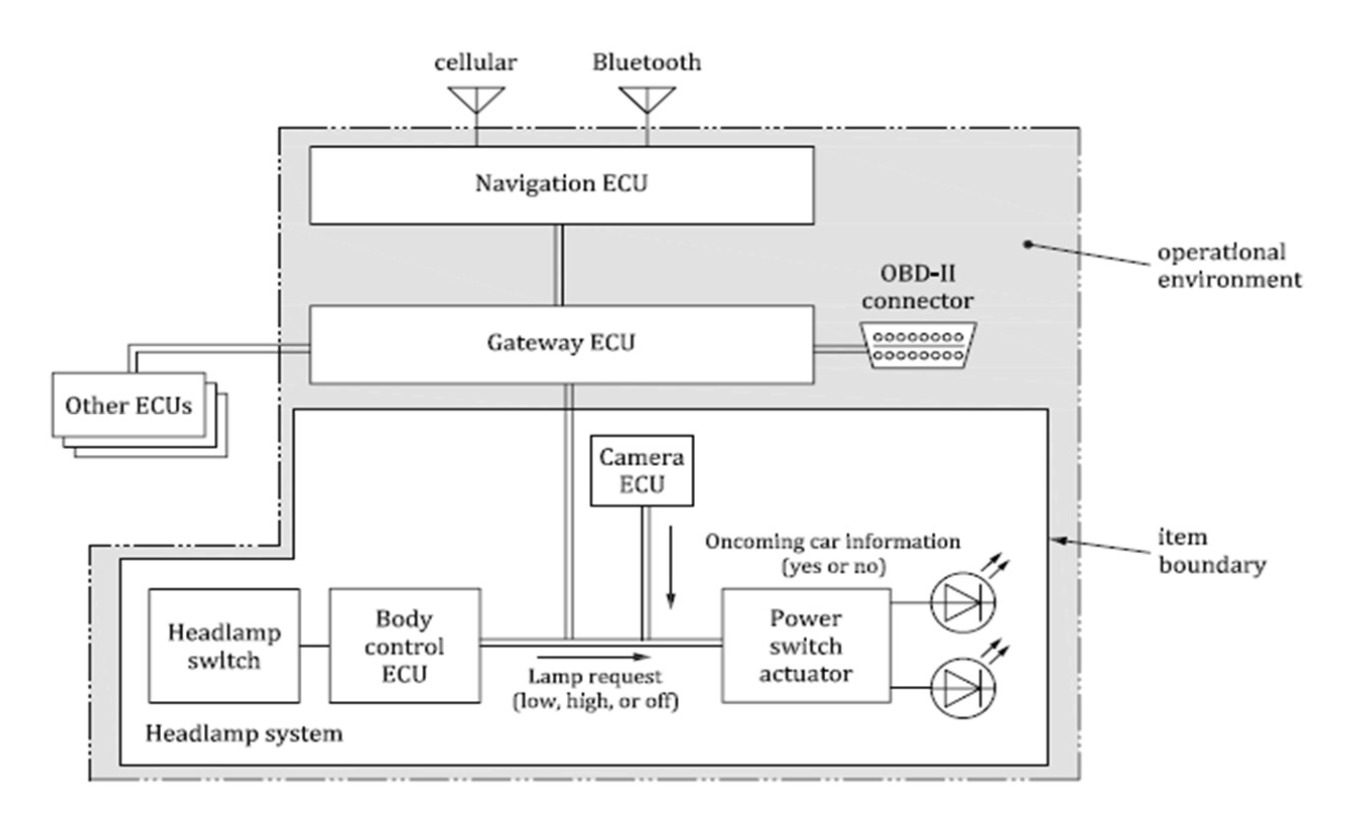
Example of item boundary and preliminary architecture of the headlamp system
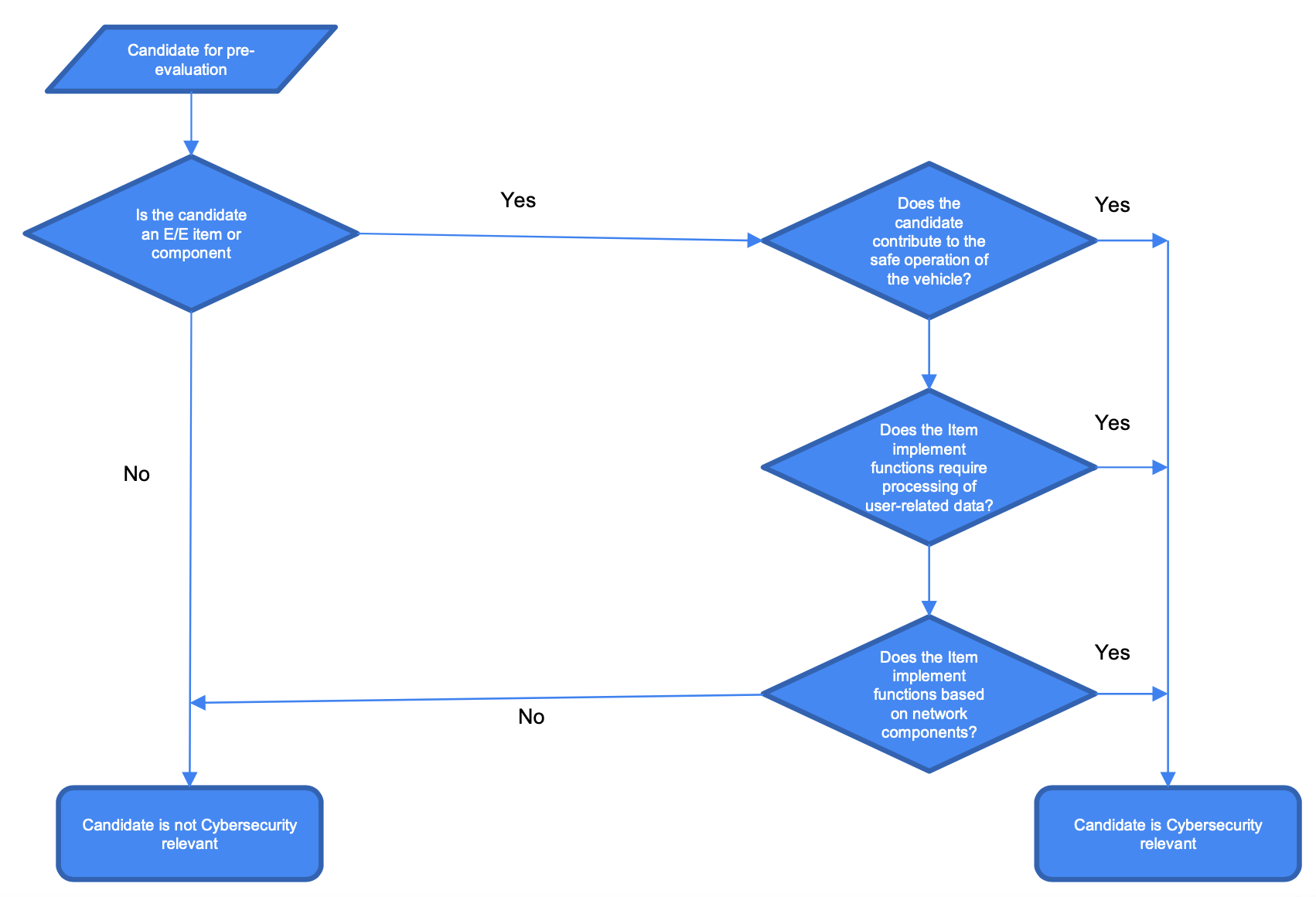
Example
Cybersecurity Relevant Candidate
- Motion control modules and modules with automotive safety integrity level (ASIL) designations
- Data related to drivers or passengers, or to potentially sensitive information such as location data.
- Internal connections -- CAN, Ethernet, media-oriented systems transport (MOST), transmission control protocol/internet protocol (TCP/IP).
Cybersecurity Properties
- Confidentiality
- Ensures appropriate access level for sensitive information
- Integrity
- Data protection from alterations, deletion by unauthorized parties
- Availability
- Ensuring the access/service remains available
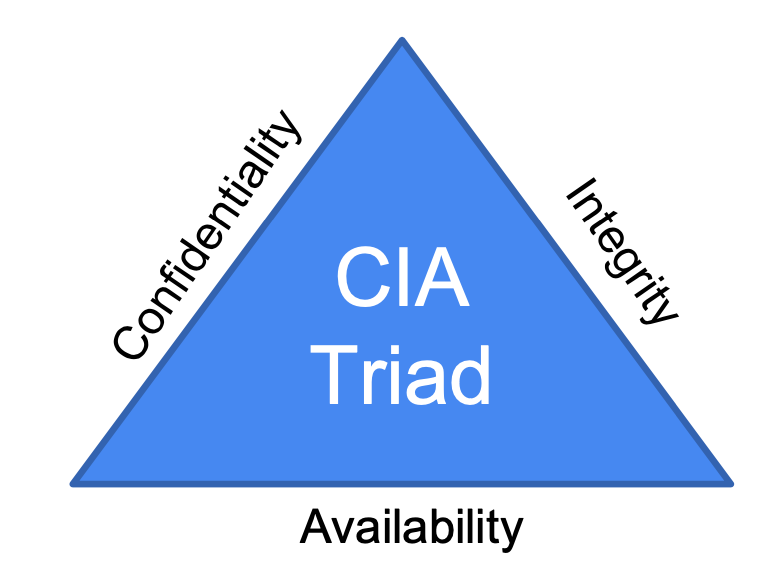
Asset Identification
Objects that have value or contribute to the value
Determine the context and composition of the product as:
- Functions
- Data
- Interfaces
- Hardware
- Software
- Networks
Asset Identification
- Identify cybersecurity properties whose compromise lead to damage scenario
- Identification of assets can be based on
- Analyzing the Item Definition
- Performing an impact rating
- Deriving assets from Threat scenarios
- Using Pre-defined Catalogues
- Define the asset(what), property(why) and the location(where)
Damage Scenarios & Impact
- Damage Scenarios
- Adverse Consequence involving a vehicle or a vehicle function and affecting a road user
- Can include relation between the functionality of the item and adverse consequence
- It can be description of harm to the road user
- Impact
- Estimate of magnitude of damage and physical harm from a damage scenario
Example of Damage Scenario
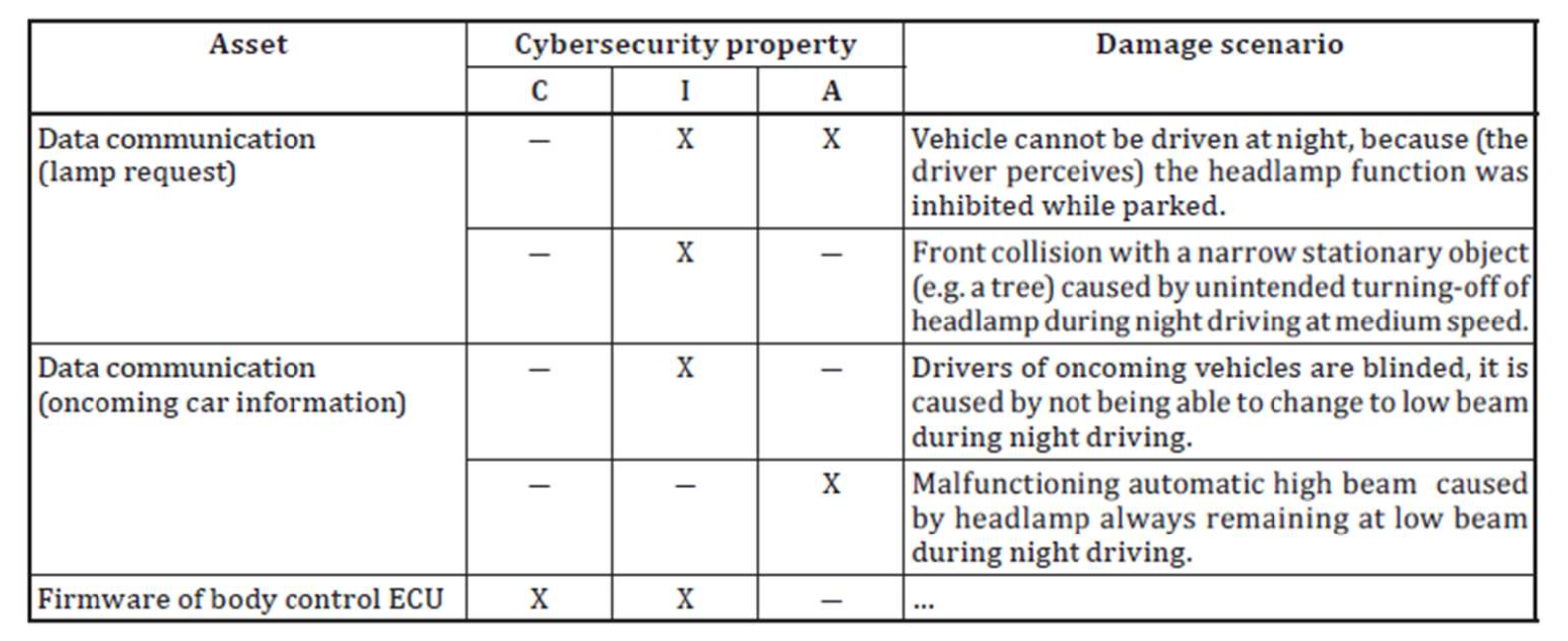
Impact Analysis
Impact
- Estimate of magnitude of damage and physical harm from a damage scenario
Impact Categories
- Safety
- Financial
- Operational
- Privacy
Impact Rate ranges
- Severe (3), Major (2), Moderate (1) and Negligible (0)
Example of Impact ratings for damage scenarios

Threat Modeling
- Step by Step procedure to identify threats and vulnerabilities
- Identify threats
- Creating architectural overview including data flows
- Identify threats, vulnerabilities and requirements
- Can consists of different levels
- Vehicle, Subsystem and Component
- Analyzing the severity of impact of the threat on TOE
- Define security objectives - CIA
- Methods
- Attack tree & STRIDE methodology
Example
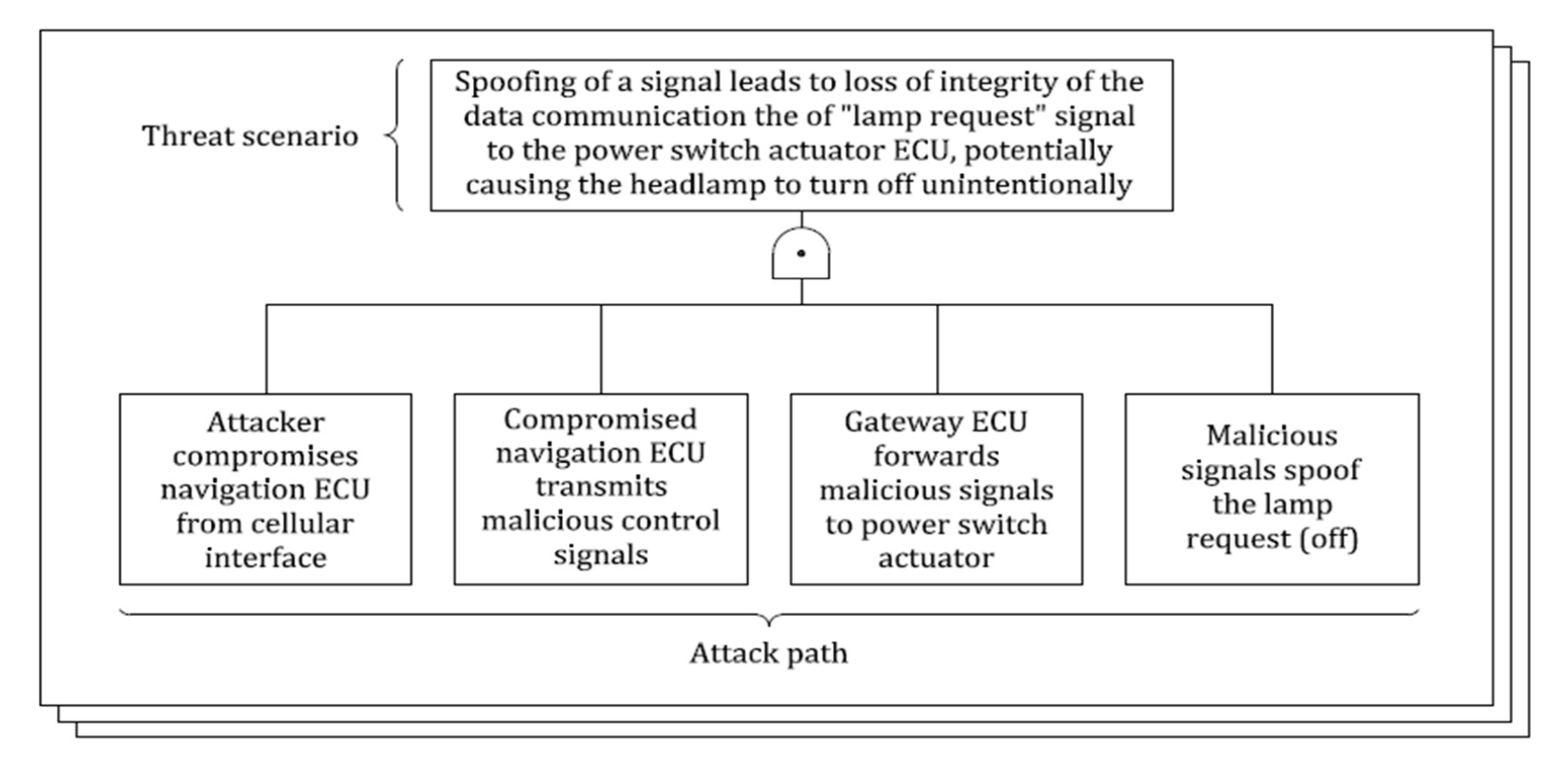
STRIDE Methodology
- Qualitative threat analysis method
- Used for identifying threats according to the purpose of the attack
- Instead of every type of attack possibility it is concise
- Reasons why STRIDE is preferred: ○ Repeatability
- Efficiency and Effectiveness based on known designs
- Easy to document vs attack trees
- Controls can be directly associated with identified vulnerabilities
Threat Scenario Identification
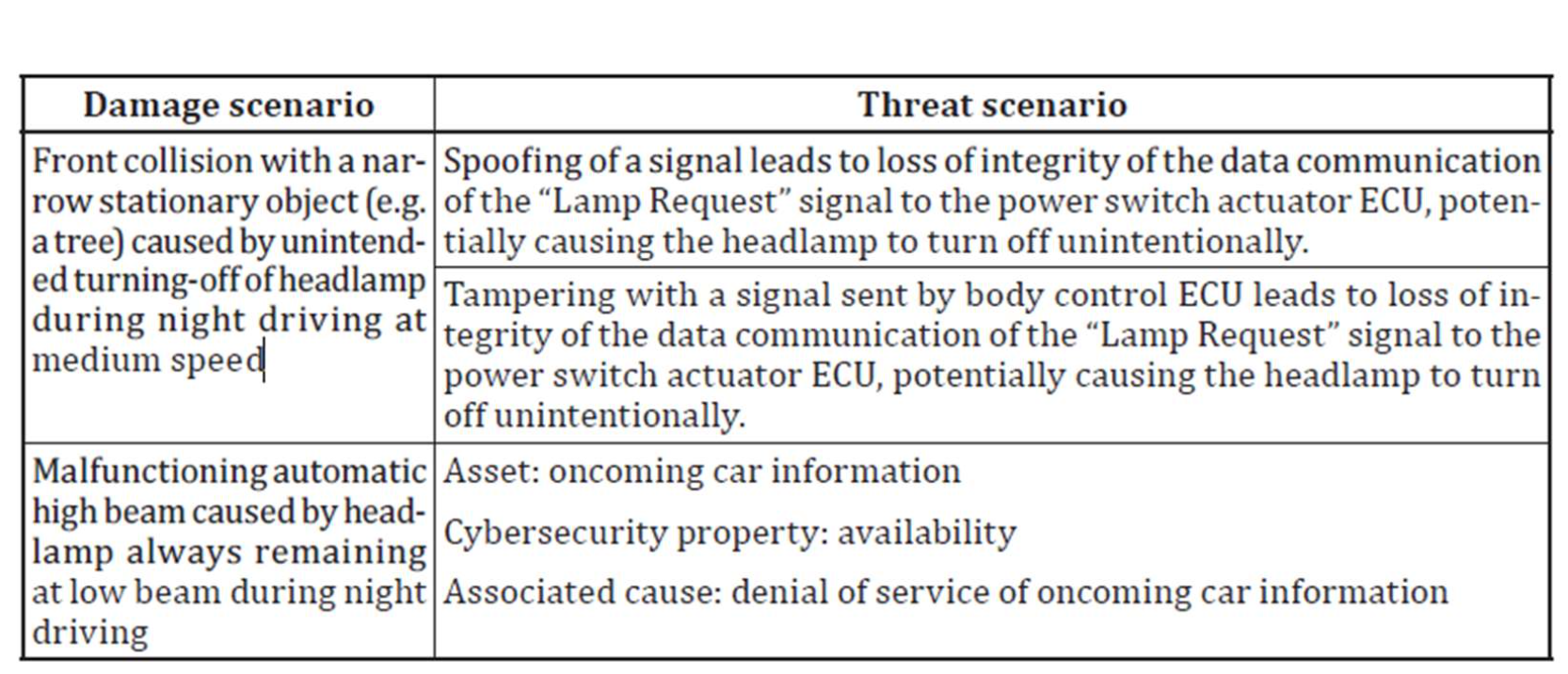
Attack Paths
| Threat Scenario | Attack Paths |
|---|---|
| Denial of service of oncoming car information | Attacker compromises navigation ECU from cellular interface. iv. Attacker floods the communication bus with a large number of messages |
| Compromised navigation ECU transmits malicious control signals | |
| Gateway ECU forwards malicious signals to power switch actuator | |
| Attacker floods the communication bus with a large number of messages |
Attack feasibility
- Attribute of an attack path describing the ease of successfully carrying out the corresponding set of actions
- Depends upon various factors
- Elapsed Time
- Specialized Expertise
- Knowledge of item/component
- Window of Opportunity
- Equipment
Attack feasibility Rating
| Threat Scenario | Attack Paths | ET | SE | KoIC | WoO | EQ | Value | Rating |
|---|---|---|---|---|---|---|---|---|
| Denial of service of oncoming car information | Attacker compromises navigation ECU from cellular interface. iv. Attacker floods the communication bus with a large number of messages | 1 | 8 | 7 | 0 | 4 | 20 | Low |
| Compromised navigation ECU transmits malicious control signals | ||||||||
| Gateway ECU forwards malicious signals to power switch actuator | ||||||||
| Attacker floods the communication bus with a large number of messages |
Risk Determination
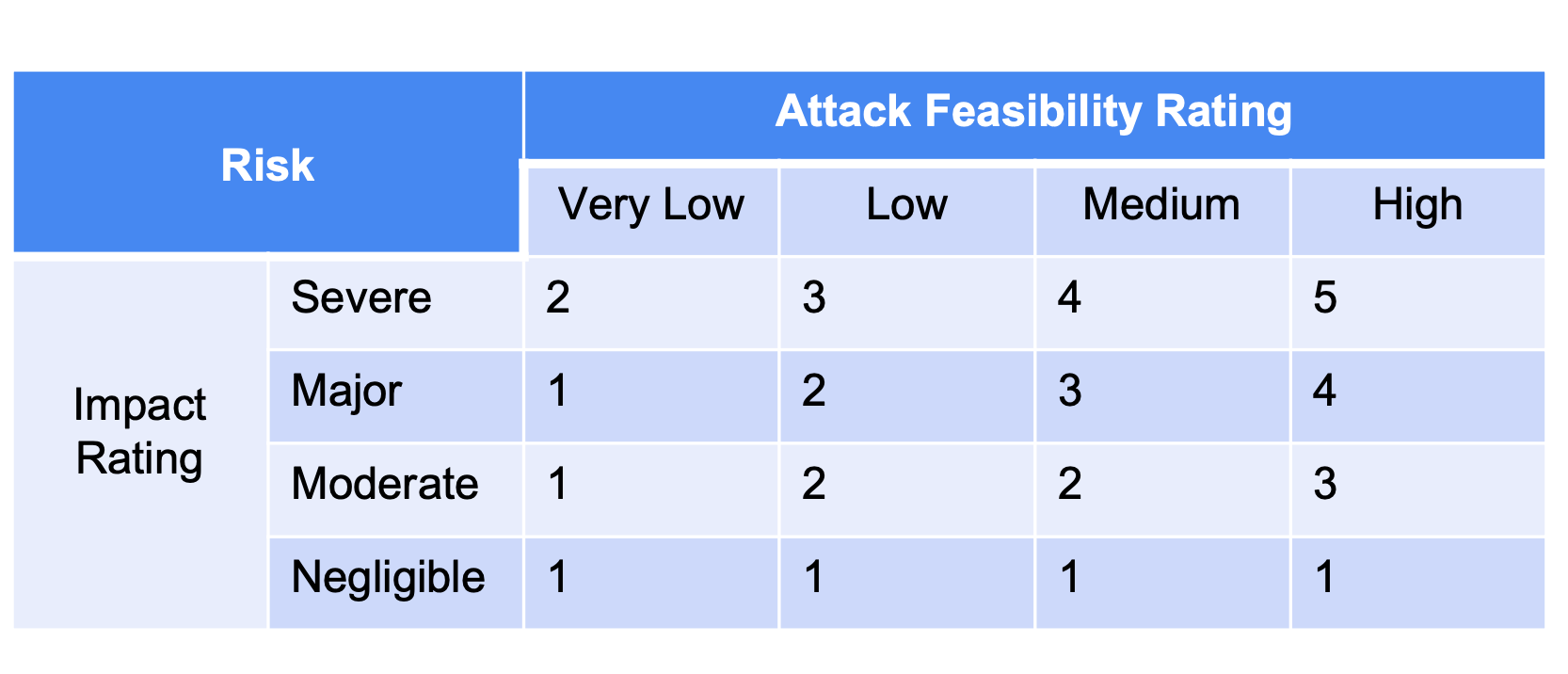
Determined Risk Values
| Threat scenario | Aggregated attack feasibility rating | Impact rating | Risk value |
|---|---|---|---|
| Spoofing of a signal leads to loss of integrity of the data communication of “Lamp Request” signal for power switch actuator ECU | High | Severe | S: 5 |
| Denial of service of oncoming car information | Low | Moderate | O: 2 |
Risk Treatment Decisions
| Threat scenario | Risk value | Risk treatment option |
|---|---|---|
| Spoofing of a signal leads to loss of integrity of the data communication of “Lamp Request” signal for power switch actuator ECU | S: 5 | Reducing the risk |
| Denial of service of oncoming car information | O: 2 | Reducing the risk |
Threat Catalog
- Tool containing a generic list of threats that are considered common in the automotive security industry
- Threat catalog contains threat classes which are based on the STRIDE methodology
- Free to download from the ASRG Website
